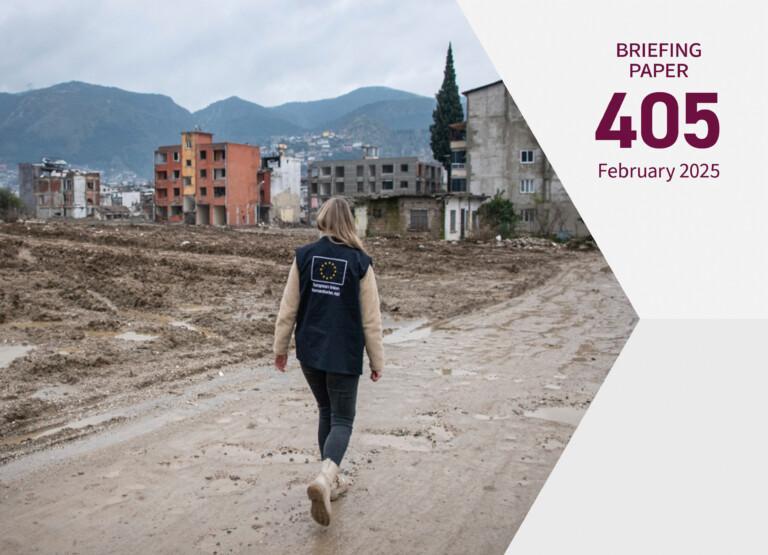
Climate change will have security effects, both directly in the form of natural disasters and indirectly through societal upheavals. In the international arena, some of these have already been recognized by political leaders.
In Finland, climate security has not emerged as a major policy issue. This may be due in part to the fact that the relatively weak ecological impacts predicted for Northern Europe do not amount to a significant sense of threat.
Yet the effects of climate change will be felt globally and will also pose indirect security threats. Therefore, Finland has a responsibility and an interest to develop its own climate security policies and participate in international cooperation in this field, with the aim of managing the phenomenon.
The securitization of climate change will not be beneficial or effective if it is only seen in terms of an imposition of traditional security practices onto climate policies. Instead, climate security discussion and policy should be based on participation and pre-emption rather than on extreme measures and emergency.
Concrete policies need to be developed to tackle climate security. Finland should contribute to this effort both at the national and the global level, focusing on areas of its own expertise such as science and technology, regional and multilateral cooperation, peace-building, or the Arctic region.
Introduction
Climate change is morphing from a dark cloud into a full-blown storm in the firmament of security threats. As scientific research has repeatedly been able to show the link between the global change in temperatures and extreme weather events already taking place, the urgency of preventive measures is becoming increasingly clear.
Globally, some steps have been taken to acknowledge the emerging security risk. President Barack Obama has maintained that the issue is the greatest long-term threat facing the world, and recently redoubled his efforts to fight against it as the greatest legacy of his presidency. Meanwhile, the US military has already taken climate change into account in its risk assessments for some years, and is now calling it a ‘threat multiplier’. The security implications were also highlighted in the fifth assessment of the International Panel on Climate Change1, and by the UN Environmental Programme (UNEP) with various issues such as conflict.2
In Finland, however, climate change has been slow to emerge as a security issue. It has primarily been seen as a part of global politics and relegated to the level of EU policy-making. Some specific issues, such as climate change in the Arctic region, have raised questions about potential security threats. Yet in practice, these concerns tend to be undermined by economic interests.
This paper will consider climate security as a political problem from the Finnish point of view. It will first discuss the ways in which climate change has been taken into account as a security issue elsewhere and contrast this with the situation in Finland. In addition, it will reflect upon the difficulties of linking climate to the security discourse, suggesting that it is not sufficient to simply apply security language and policies to a new set of problems. The paper will go on to argue that inaction on climate security is not a viable long-term strategy for Finland as the security threats and the policies to address them become more acute. Finally, it will propose measures to combine input from natural and social sciences as well as policy-making to formulate concrete climate security policies.
Conflict links and disaster risks – climate security topics in Finland and elsewhere
The effects of climate change are usually presented through rather straightforward predictions, such as a rise in the global average temperature of about 2 degrees Celsius over the next century. While these arguments sound alarming, they may also create a sense that climate change will only be actualized in the distant future. This is a misleading interpretation, as any temperature rise will obviously not take place overnight but as a progressively creeping development.
This false sense of security has been shaken to some extent by extreme weather events like hurricanes and heatwaves. While these are by no means a new occurrence, scientists have traced some of their increasing frequency to the global temperature rise. Extreme weather also appears to increase public awareness of and, consequently, concern about climate change. So far, however, research has struggled to effectively communicate the linkage between an extreme weather event and general climate change.3
Conversely, the range of topics linked to climate security continues to grow. Extreme weather threatens human lives and health directly, but it also poses risks to vital infrastructure like energy networks and water management. A rise in the sea level will concretely threaten the existence of small island developing states such as Kiribati and the Maldives, but coastal areas all over the world are at risk as well. Human security will deteriorate as resource scarcities like crop failure and water shortages will potentially affect over a billion people around the world.
Such problems will have societal and economic ramifications that may shake socio-political structures and give rise to instability. Through this linkage, climate change may, in combination with other factors, contribute to the creation or continuation of conflicts. Furthermore, climate impacts will particularly affect developing countries with societies and populations that are vulnerable to environmental and political risks. This is likely to accentuate inequalities between the Global South and North and have several destabilizing effects. Increased migration is predicted to be one consequence, although estimates vary considerably concerning the size and direction of the migrant flows.4
As knowledge about the worrying future prospects accumulates, the climate threat has risen onto the international agenda and has increasingly come to be seen as a security issue. In the run-up to the Paris Agreement on climate change, reached in December 2015, Barack Obama was joined by the likes of Kofi Annan in calling for urgent global action precisely because of the security threats. Climate change also features strongly in the EU’s Global Strategy for Foreign and Security Policy. The UN Security Council (UNSC) has discussed the issue several times, although it has not been able to reach a consensus on ways to address the topic.5 Although the result of the recent presidential election in the US is likely to change the setting in global climate politics to some extent, the security aspects have gained enough prominence not to be swept under the carpet in the new situation.
For its part, the EU may not have featured in the climate security discussion as prominently to outside observers as the US, but the issue has gained relevance within its institutions. Among other things, climate security is featured within the foreign policy Instrument contributing to Stability and Peace and has been taken into account in early warning mechanisms, thus integrating it as an element in disaster risk reduction and conflict prevention.6 Such operationalization of the issue may well be more important in terms of impact than high-level declarations.
The scale of attention inevitably raises some questions about its consequences. In international relations theory, the linkage of climate to security has been studied as ‘securitization’, in which security is constructed as an inter-subjective process brought about by the presence of an existential threat. This analytical approach enables an examination of the aims of the actors involved and the outcomes of the process itself. The original securitization theory cautioned against the excessive securitization of new issues, arguing that it may be harmful as it moves them beyond the normal democratic procedure into a sphere of emergency decision-making.7 However, other scholars have since challenged this, proposing that the security sector is inevitably faced with new challenges and therefore needs to adopt new practices to come to terms with them. Rather than the security sector taking over climate issues, this may instead result in a kind of ‘climatization’ of security.8
This multifarious discussion on climate security is in contrast with that taking place in Finland, where the theme remains marginal. Key documents like the white papers on Finnish Foreign and Security Policy as well as the Security and Defence Policy both acknowledge climate change as a factor affecting the security situation, but do not propose concrete steps to address it. Rather, the issue is seen to fall under EU foreign policy or development policy. Yet Finland has not been active on the topic in the EU context either.
This may be due to the fact that in all predictions, Finland is foreseen to experience only moderate climate change impacts. A slight increase in the frequency of heavy rainfall or flooding may be unfortunate, but pales in comparison to the catastrophic scenarios that have urged action in other countries.
Yet the relative safety is no excuse for inaction; quite the contrary, in fact. First, Finland is by no means isolated from the ramifications of the global climate impacts, be they physical or political. Food crises, migration or geopolitics will not stop at the Finnish borders, and therefore need to be taken into account in our own security policy. Meanwhile, the EU has been diagnosed as seriously vulnerable to climate impacts in its near abroad, especially the Mediterranean and Middle East regions.
Second, Finland does have some specific climate-related risks within its borders that have not been adequately considered. The Arctic region is a crucial case as it is projected to endure an even larger rise in temperatures than the rest of the world. The development will dramatically change the regional environment but also enable the extraction of new deposits of natural resources, including oil.9 As a result, the Arctic has become a focus of geopolitical and security interests at an international level. While Finland has officially expressed concern about environmental security in the region, it is also hoping to benefit from the economic opportunities brought about by climate change, thus potentially further aggravating the risks. This contradictory approach appears to be emblematic of Finland’s climate security policy so far.
Third, the security implications of climate change form an emerging policy discourse that will heat up along with the global temperature. As the climate impacts become more acute, the measures to prevent and contain them will need to become increasingly urgent. This may lead to emergency politics that will not necessarily produce democratic, let alone the most economical or efficient solutions to deal with climate threats. Finland could anticipate this by taking on an active role in formulating climate security policies, rather than merely passively adopting them. The logical context for this is the EU climate security policy, which gives the issue a far wider global relevance.
Securitization of climate change as policy and politics
In spite of the increasing necessity of discussing the security implications of climate change, the climate security approach does not provide easy solutions. As mentioned above, securitization has also been seen as harmful, even in the original theory itself. On the other hand, the current debate has perhaps been excessively technical, neglecting the political and societal consequences that a security perspective could and should illuminate. The key, therefore, is not to arbitrarily impose security onto the climate agenda, but rather to develop the kind of security practices that help to address the threats.
Yet in scholarly debate, there has been a tendency to see climate security as an attempt to reduce the discourse to just one perspective. This is evident, for example, in the debate about the potential of climate change to cause conflicts. Some scholars argue that the ‘climate-conflict nexus’ is futile as various studies show that climate conditions alone do not explain conflict occurrence; instead, there are always societal and political factors at play as well.10 Others, however, point out that this does not diminish the relevance of climate as a factor that increases vulnerability. This not only makes it a threat multiplier, but also suggests that it would be beneficial to take the changing climate into account in peacebuilding operations.11
Meanwhile, predictions about climate migration have been challenged on the grounds that the security narrative they produce is based on shielding the Global North from the threat posed by migrants, who are simultaneously reduced to a victim status.12 Such an approach is not conducive to either solving the migrant crisis or preventing climate change. Yet at the same time, a complete rejection of a linkage between climate and migration and its possible security implications could leave important interactions unexplored. In the light of current scientific assessments, climate refugees do not appear as ‘apocalyptic narratives’, but as one important and likely outcome of climate change.
The securitization of climate has also been associated with a shift in the discussion towards adaptation as opposed to mitigation; that is, attempting to prepare for coping with climate impacts rather than preventing them. Adaptation measures usually aim to strengthen community capacity at the local level, for example by strengthening natural buffers in vulnerable ecosystems or improving the sustainability of farmland management. Such efforts reflect an increasing understanding that climate change cannot be fully reversed, making it a high priority to minimize its effects. However, an excessive emphasis on adaptation may indeed run the risk of neglecting mitigation, which should still be seen as the long-term imperative.
This is particularly distressing with regard to the issue of ‘tipping points’, raised by climate scientists to describe thresholds beyond which climate change will trigger irreversible impacts on entire ecosystems, such as the melting of Polar ice caps or the permafrost.13 In these cases, adaptation is virtually impossible and mitigation is the key. Tipping points present existential threats and therefore quite obviously pose security questions. However, they also show that climate security has to go beyond pointing out threats towards actually formulating policies to counter them. Yet it is not enough to merely point out that the sea level is rising or coral reefs dying, thus adding to a sense of emergency that may give rise to hasty and short-sighted policies.
It is therefore clear that climate security goes well beyond a mere militarization of climate change. To be able to tackle challenges as varied as migration or rising sea levels, climate security policies have to work through diverse approaches like human security, vulnerability and ecological risk. Questions of justice and equality feature strongly in this discussion, particularly because of the uneven division of climate impacts between the Global North and South. Thus, instead of limiting the climate change discussion, the security approach has the potential to highlight the cross-sectoral implications of the interactions involved.
Indeed, in many cases, such as the tipping points, the security consequences of climate change are so obvious that a failure to consider them could have the effect of restricting democratic discussion rather than vice versa. Rather than reject the security linkage, therefore, it is necessary to recognize its political implications while acknowledging that these can either be useful, such as highlighting the urgency to act cooperatively to prevent climate change, or deleterious, for example by excessively directing the discussion towards military solutions. This also means that climate security issues need to be considered on the basis of each specific case.
Hence, the focus should be on developing useful practices to tackle climate security in different fields, such as humanitarian relief or peacebuilding. Whether this is seen as a ‘climatization’ of security or the emergence of a new field within the sector, it does reflect the need for a new kind of security logic to deal with new kinds of security threats.
Closing the gaps between science, security and policy
The major question is how to translate the recognition of climate change as a security issue into a coherent and effective policy without resorting to interpretations that might do more harm than good. This consideration needs to take place at the international level, as an integral part of climate diplomacy, development policy and other relevant fields, but also as a matter of national governance. Finland would benefit from contributing to this emerging policy discussion at all levels.
At the moment, climate security appears to be plagued by a degree of discrepancy caused by the inability of natural sciences, social sciences and policy-makers to thoroughly understand one another. This easily leads to simplifications that discourage and, in the worst case, misinform policy-making. Better communication between these key fields is therefore necessary, such as in the case of conveying the relationship of extreme weather events to climate change as a whole. Finland, as a country with solid expertise in climate sciences, could contribute by facilitating interdisciplinary dialogue as well as exchanges with policy-makers. This effort should also have the aim of formulating a climate security policy for Finland and informing the discussion at the international level.
Cooperative solutions combining climate science with policy are required for ecological phenomena like the tipping points, but also for societal issues like migration, food security and water supply. However, they also need to be streamlined into policies at the sectoral level in order to strengthen their functionality to be employed as practices. Throughout all of this, climate security should focus on participation and pre-emption rather than extreme measures and emergency.
For one thing, Finland should thoroughly evaluate the ways in which climate change will affect its security status, not only in terms of extreme weather and other environmental events, but also with regard to geopolitics, energy supply, international commitments and other relevant points of view. The outcomes of these evaluations should be used to develop concrete measures to address the potential threats. However, even if the security linkage is duly made, it does not mean that all the resulting policies have to be limited to the security sector.
In terms of Finnish national interest, an obvious and acute climate security case is that of the Arctic. Finnish policy should aim to consider the climate security of the region as a coherent whole comprising the environment, geopolitics, economics, justice and other issues. In particular, it should take into account the potential controversies that arise when short-term economic gains and long-term security interests end up at odds. Moreover, in spite of being a small country, Finland should take a regional and global perspective. Tackling climate threats unilaterally is impossible, which necessitates gaining leverage through the EU level and international cooperation. By actively participating in the policy-making, Finland could be in a position to influence climate security policy well beyond its relative size, especially in fields where it has particular competencies. As a well-known actor in peacebuilding, Finland could focus efforts on promoting the incorporation of climate security into conflict-prevention and stability policies. The EU has already linked climate security to its peacebuilding operations, which gives it an additional channel for influence.
As climate change advances, security threats will grow and new ones will emerge. The precise impacts of these developments are extremely difficult to predict, yet ignoring them will hardly make them disappear. The challenge is to come up with solutions that will, regardless of the problem of incomplete knowledge, be helpful in fighting climate change and that won’t create new problems. As this paper has argued, Finland has both a responsibility and an interest to participate in this work. The sooner this commitment is undertaken, the better, as climate change won’t wait.
Endnotes
1 IPCC (2014). Climate Change 2014: Impacts, Adaptation, and Vulnerability. Part A: Global and Sectoral Aspects. Contribution of Working Group II to the Fifth Assessment Report of the Intergovernmental Panel on Climate Change. Cambridge University Press, Cambridge and New York.
2 UNEP (2011). Livelihood Security: Climate change, conflict and migration in the Sahel. UNEP, Geneva.
3 Antal, M., & Hukkinen, J. I. (2010). “The art of the cognitive war to save the planet.” Ecological economics, 69(5), 937–943.
4 IOM (2008). Migration and Climate Change. IOM Migration Research Series 31. Available at http://www.iisd.org/pdf/2008/migration_climate.pdf. Last accessed 22 Nov 2016.
5 Warren, D. (2015). Possible Roles for the UN Security Council in Addressing Climate Change. Sabin Center for Climate Change Law, Columbia Law School; available at https://web.law.columbia.edu/sites/default/files/microsites/climate-change/warren_-_cc_and_international_peace_and_security_-_roles_for_the_un_security_council.pdf. Last accessed 22 Nov 2016.
6 Zwolski, K., & Kaunert, C. (2011). “The EU and climate security: a case of successful norm entrepreneurship?” European security, 20(1), 21–43.
7 Buzan, B. et al. (1998). Security. A New Framework for Analysis. Lynne Rienner, Boulder-London.
8 Oels, A. (2012). “From ‘securitization’ of climate change to ‘climatization’ of the security field: comparing three theoretical perspectives.” In Climate change, human security and violent conflict (pp. 185–205). Springer Berlin Heidelberg; Trombetta, M. J. (2008). “Environmental security and climate change: analysing the discourse.” Cambridge Review of International Affairs, 21(4), 585–602.
9 Käpylä, J., & Mikkola, H. (2016). “The promise of the geoeconomic Arctic: a critical analysis.” Asia Europe Journal, 14(2), 203-220; Gritsenko D (2017). “Arctic energy: Resource colonialism revisited.” In Kuzemko C., Goldthau A., Keating M. (eds.) Handbook of International Political Economy of Energy and Natural Resources. Cheltenham: Edward Elgar.
10 Raleigh, C., Linke, A., & O’Loughlin, J. (2014). “Extreme temperatures and violence.” Nature Climate Change, 4(2), 76–77.
11 Gemenne, F. et al. (2014). “Climate and security: Evidence, emerging risks, and a new agenda.” Climatic Change, 123(1), 1–9.
12 Bettini, G. (2013). “Climate barbarians at the gate? A critique of apocalyptic narratives on ‘climate refugees’.” Geoforum, 45, 63–72.
13 Hansen J. (2008). “Tipping point: Perspective of a climatologist.” In Fearn, E. (Ed.) The State of the Wild: A Global Portrait of Wildlife, Wild Lands, and Oceans. Wildlife Conservation Society/Island Press, Washington, D.C., 6–15.







